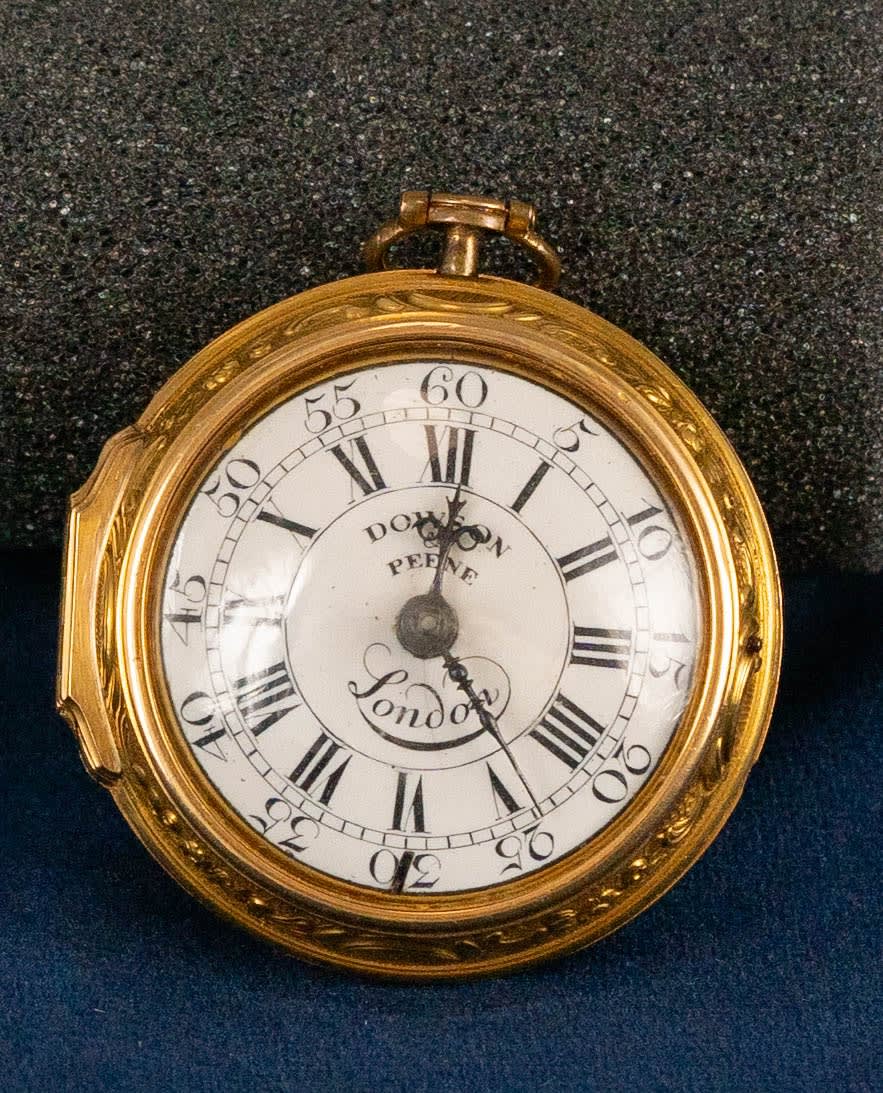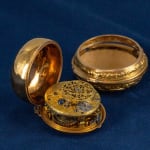Dowson & Peene
Further images
A very attractive Georgian II eighteen carat gold pocket watch by Dowson & Peene, signed Dowson & Peene London on the white enamel dial and signed on the movement Dowson & Peene Gray’s Inn London and numbered 1410 and also inscribed inside the case T.B - the initials of the case maker. The dial with Roman numerals for the hours and outer Arabic numerals for the five-minute intervals, with a fine pair of blued steel hands. The fusee movement, timepiece only with outside count wheel and a beautiful foliate pierced cock. The outer case featuring a scene from the antique with an Emperor seated on the left and a centurion standing to his right, beside which is a portrait bust.
London, date circa 1755
Width 5cm.
This elegant pocket watch was made by Dowson & Peene of Gray’s Inn, London. John Dowson (b. c. 1719 d. 1795), worked more actively as a retailer rather than as a clock and watchmaker. Several clocks are also signed Dowson and Peene, including a George III table clock of circa 1760 (offered by Dreweatts, Donington Priory September 2012). The name Peene may well refer to the goldsmith Robert Peene who was granted the Freedom of the Goldsmiths’ Company in 1755 and died shortly after in in 1756/7, at Holborn London. In his will, which was proved in 1757, Peene appointed John Dowson as one of his two executors and left money to both John and his wife Ann Dowson; significantly 1757 was the year in which Dowson was able to purchase his Freedom of the Goldsmiths’ Company. He was then elected to the Company six years later. In an article about John Dowson, John Robey notes that John Dowson was indeed married to Ann and that he had London premises at Gray’s Inn (as inscribed on the movement), as well as at Holborn and later in Hatton Garden. In addition to London, Dowson worked in Bath, where he was in partnership with Thomas Field and then Michael Atkinson.
John Robey notes that the first record of Dowson’s activity in London was as a watchmaker working in the parish of St Andrews, Holborn in 1747 when he took on an apprentice and then later in 1754, by which time he was also based at Gray’s Inn, three years before he became a Freeman of the Goldsmith’s Company by redemption. He was also listed in the trade directories as a goldsmith working at 77 Holborn Bridge and Field Court, Gray’s Inn from 1765-90, while a few directories simply list him as a merchant.
As already stated, Dowson also traded in Bath, then a genteel city, attracting richer members of society from London and elsewhere. This presented a great opportunity for enterprising merchants and tradesmen to supply fashionable clothes, jewellery, fine furniture and, of course clocks and watches to affluent customers. For an enterprising tradesman such as John Dowson, Bath was an obvious place to expand his business. We can assume that he was already trading in Bath by 1760, since Britten cites a watch of that year that is signed or inscribed Dowson Bath In about 1767 Dowson was in partnership with Thomas Field at Northgate Street, who had himself moved to Bath from London. This partnership lasted up until 1773, when soon after the Bath Chronicle advertised that John Dowson, ‘Clock Watch-maker and Goldsmith’ was continuing the shop in Northgate Street, and that “notwithstanding Mr Field and him are parted, he continues in business as before having sent from his shop in London a set of able hands …. He has also sent down from his warehouse in Grays Inn London a large assortment of Silver and Jewellery and Cutlery Goods which are of the best and newest taste”. Following his association with Thomas Field, Dowson then went into partnership with Michael Atkinson (d. 1793), with the latter looking after the Bath shop and John Dowson spending most of his time looking after his London interests. Their business continued until their respective deaths - Atkinson in March 1793 at Bathampton and Dowson two years later in London, where he was buried in a non-conformists burial ground at Bunhill Fields. By then he and his wife Ann were no longer together. Instead, Dowson had been living with Elizabeth Hamilton, who was an executor and the main beneficiary of his will.





